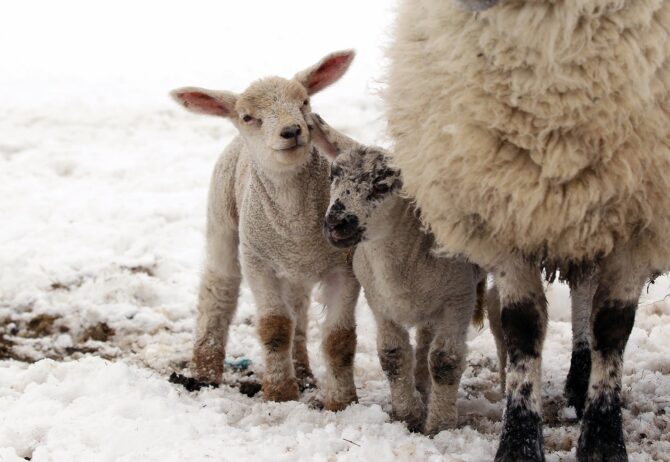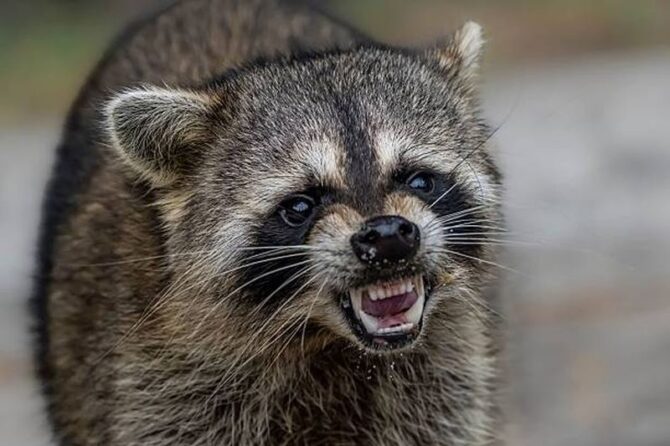Africa’s natural beauty is unmatched, luring you to gaze at the passive stride of a lioness that you forget to breathe and marvel at a giraffe’s tripod bent to water.
The continent’s jungles, savannahs, forests, and other natural habitats contain mysteries that even a wise man cannot understand.
Therefore, seeing one-tenth of these African animals would bring about an incredible safari escapade.
It would be impossible to find all of Africa’s wildlife species, prompting us to compile a list of thirty African safari animals you need to see, including lions, elephants, zebras, and antelopes, among others.
Each animal we will consider has its scientific name, geographical range, conservation status, and photo highlighted, with a description that features the best places to find them.
So come along with us as we explore the beautiful world of these animals you can see on an African safari.
African Safari Animals You Should See
1. Lion

- Scientists Name: Panthera Leo
- Conservation Status: Vulnerable
Lions are endemic to Africa, occluding in savannahs, scrublands, grasslands, grassy plains, open woodlands with bushes, and bordering rivers.
Between 300 and 1,500 mm of annual rainfall, Savannahs constitute most African lion habitats.
Some populations reside in West African tropical moist forests and montane forests.
Sadly, Africa’s lion population has declined substantially by fifty percent in only twenty years.1
However, one can still find lions in the Kgalagadi Transfrontier Park, South Africa, and Serengeti National Park, Tanzania.
2. Leopard
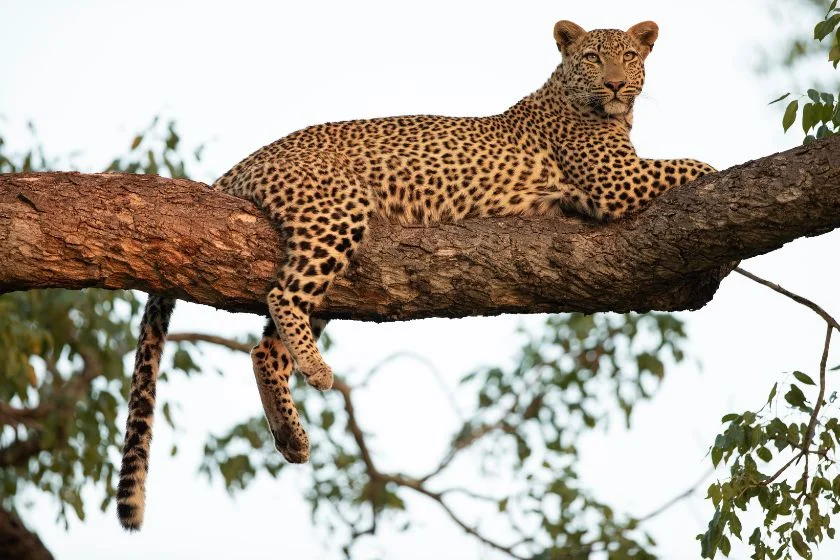
- Scientific Name: Panthera pardus
- Conservation Status: Not Extinct
The leopard resides across sub-Saharan Africa and is aboriginal to many African nations.
These spotted cats inhabit the Cape Provinces of South Africa, Somalia, Ethiopia, and West Africa, occurring in mountainous forests, grasslands, and savannahs.
Leopards are among Africa’s “Big Five” safari, attracting many tourists; Zambia’s South Luangwa National Park and South Africa’s Sabi Sands Game Reserve are some of the most prominent leopard centers in the continent.
The Virunga National Park in the Democratic Republic of the Congo has recorded leopard sightings as the animals drink the park’s thermal waters.
3. Elephant

- Scientific Name: Loxodonta africana
- Conservation Status: Endangered
African elephants are considered endangered by the IUCN; still, they are indigenous to the continent, inhabiting the Sub-Saharan arid regions and Sahelian scrub.
They also reside in the continent’s jungles in tropical rainforests, mopane, and miombo woodlands.
African elephants primarily have populations in Central Africa.
Still, they exist in the Chobe National Park in Botswana, the Amboseli National Park in Kenya, East Africa, and the Hwange National Park in Zimbabwe, Southern Africa.
Also See: List of Animals with Big Heads (with Pictures)
4. Rhinoceros

- Scientific Name: Rhinoceros
- Conservation Status: Critically Endangered
The black rhino species is endemic to Africa, living in its eastern and southern regions.
Rhino populations inhabited eleven countries, but most wild rhinos today, from the estimated six thousand, occupy only four countries — Zimbabwe, South Africa, Namibia, and Kenya.
They roam the open savannahs and grasslands and naturally exist in Etosha National Park, Namibia, Ziwa Rhino Sanctuary in Uganda, Nairobi National Park, Kenya, and Kruger South Africa.
Black rhinos have a size worthy of making them major African wildlife, growing up to 5.2 feet, and weighing 1,760 to 3,080 pounds.
5. Buffalo
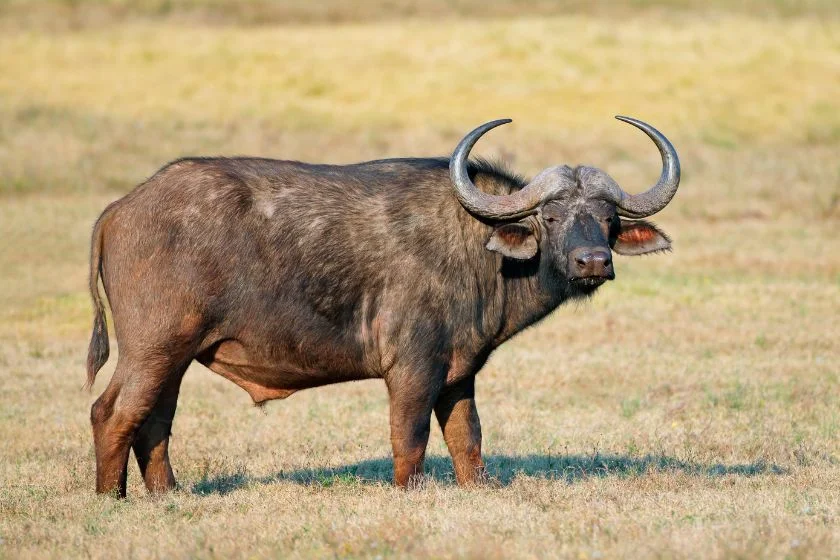
- Scientific Name: Syncerus caffer
- Conservation Status: Near Threatened
Various species of the African buffalo occupy every part of the continent. The Cape buffalo inhabits Southern and East Africa, while the forest buffalo occurs in Central and West Africa.
These species are enormous, measuring up to 5.6 feet in shoulder height and weighing up to 1,900 lb.
They live in savannahs, swamps, mopane grasslands, and densely covered habitats.
Some wildlife parks include Masai Mara National Park in Kenya, Chobe National Park in Botswana, and Serengeti National Park in Tanzania.
6. Hartebeest
- Scientific Name: Alcelaphus buselaphus
- Conservation Status: Least Concern
The hartebeest is an antelope species native to the black continent.
It is a large-sized species with a prominent hump, a large chest, and a long face that distinguishes it from other antelope species.
Hartebeests are primarily grazers, with grasses making their menu, but they mostly occupy wooded grasslands, dry savannas, and open plains in Central, West, southern, and southeast Africa.
The hartebeest roams in their natural habitats in the Kruger and Bontebok National Parks in South Africa, Etosha National Park in Namibia, and Camp Linyanti in Botswana.
7. Bongo

- Scientific name: Tragelaphus eurycerus
- Conservation Status: Critically Endangered
The bongo is another antelope species native to African jungles, with white-yellow stripes and black-and-white markings on its reddish-brown coat.
Bongos exist in tropical forest mosaics with dense undergrowth around West and Central Africa.
The Aberdare National park in Kenya is one major spot to find the bongo.
8. Okapi
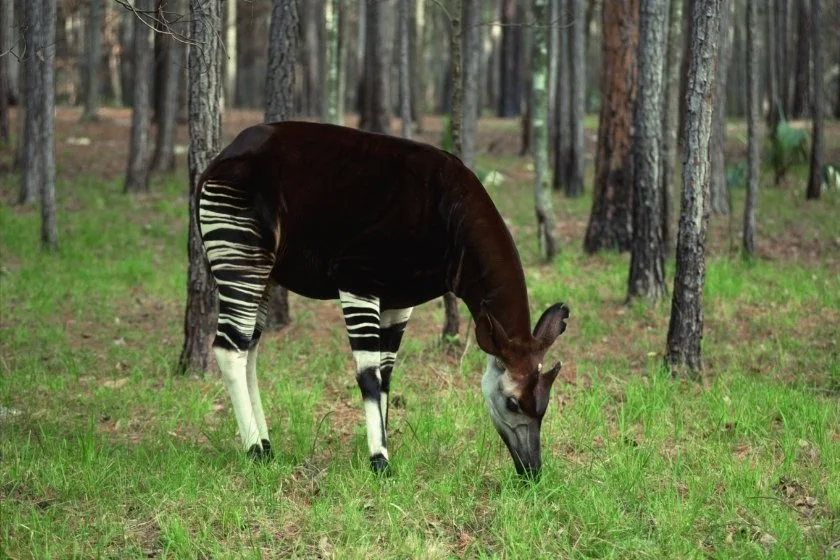
- Scientific name: Okapia johnstoni
- Conservation Status: Endangered
The okapi, a zebra look-alike, is the only extant member of the Giraffidae family along with the giraffe.
However, the okapi is not as tall as a giraffe, measuring only four feet and eleven inches.
It occupies canopy forests but is essentially solitary, with wildlife populations in the Okapi Wildlife Reserve, Ituri Rainforest, and Virunga National Park in the Democratic Republic of Congo.
9. African Wild Dog

- Scientific Name: Lycaon pictus
- Conservation Status: Endangered
The African wild dog is a threatened species now mostly located in the southeast of Africa, with only over 6,000 individuals left.2
These wild dogs primarily inhabit Africa’s savannas and dry regions, preying mainly on antelopes.
African wild dogs have a strong sense of socialization to form packs of about thirty dogs.
The best places to find the African wild dog include woodlands, scrublands, and mountains, and they are open to the public in their natural habitats in:
- Madikwe Game Reserve in South Africa
- Mana Pools National Park in Zimbabwe
- Moremi Game Reserve in Botswana
- Selous Game Reserve in Tanzania
- South Luangwa National Park in Zambia
Also See: Different Types Of Wild Dogs (Species List With Pictures)
10. Hyena

- Scientific Name: Hyaenidae
- Conservation Status: Least Concern
Hyenas occupy Africa’s savannas, sub-desserts, grasslands, forest edges, and woodlands and hold an apex position on the food chain.
Hyenas control prey populations and prevent the spread of diseases, primarily by consuming animal remains that could rot and cause diseases.
They have unparalleled bone-crushing abilities, helping them fight off potential competitors.3
Hyenas may not be among the most beautiful animals, but they attract visitors around Kruger National Park and Pilanesberg National Park in South Africa.
11. Wildebeest
- Scientific Name: Connochaetes taurinus
- Conservation Status: Least Concern
The antelope’s imposing appearance is why the Afrikaans named it the wildebeest.
However, it is never too fearsome to the African wild cats, wild dogs, and hyenas that constantly prey on it.
Wildebeests are among the jungle animals in southern Africa that also occupy grassy plains and open woodlands that support their grazing routine in Angola, Botswana, South Africa, Mozambique, and Tanzania.
The Serengeti National Park in Tanzania and Masai Mara National Reserve in Kenya are some of the best places to watch the wildebeest.
12. Warthog

- Scientific Name: Phacochoerus africanus
- Conservation Status: Least Concern
The common warthog is a plump, hooved wild pig with little fur, a mane through the spine to the middle of its back, and upper tusks that protrude upwards from the mouth.
Warthogs, commonly called Pumba by many safari guides, are among Africa’s highly-watched safari animals.
They reside in grasslands, savannas, and woodlands in sub-Saharan Africa, across western, eastern, central, and southern Africa.
The Kruger National Park, South Africa, and Meru National Park, central Kenya, are famed for housing the warthog.
13. Vulture
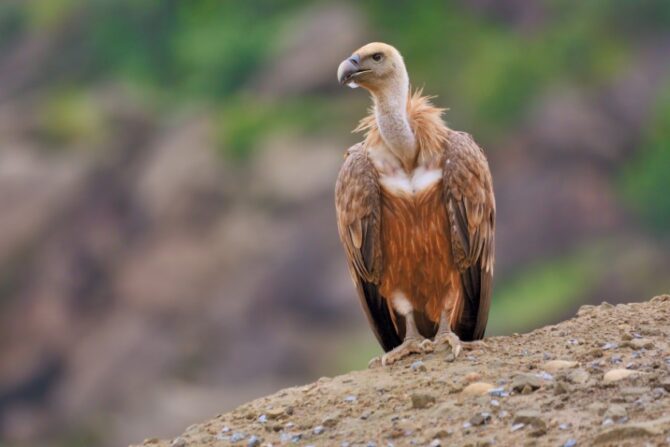
- Scientific Name: Accipitridae (Old World vultures); Cathartidae (New World vultures)
About eleven vulture species from the Accipitridae and Cathartidae families reside in Africa, popular among many as a scavenger and keystone species in most of the continent’s ecosystem.
Sadly, about seven of eleven African vulture species are critically endangered, with West Africa losing about ninety percent of the native White-backed vulture.4
However, vultures spread across the black continent in west, north, east, central, and southern African cliffs and tall trees.
The Kruger National Park in South Africa and Comoé National Park have vultures, and one might be fortunate to find one while visiting.
Also See: African Birds: 30 Amazing Safari Bird Species, With Pictures
14. Marabou Stork

- Scientific Name: Leptoptilos crumenifer
- Conservation Status: Least Concern
While most storks are beautiful, the marabou stork has a reputation for horror due to its black cloak, large, fleshy pouch, and featherless features.
However, even the world’s most unattractive creatures attract large fanbases, explaining why the marabou stork ranks among Africa’s safari animals you should see.
Marabou storks are also large birds, reaching four feet, eleven inches in height, and 6.5 feet in wingspan length.
The IUCN ranks these birds as ‘Least Concern,’ with a stable population to support their evaluation.
Therefore, one can find the marabou stork in the west, east, central, and southern Africa.
One can find the marabou stork in Ben Lavin Nature Reserve and the African Bird of Prey Sanctuary in South Africa.
15. Hirola
- Scientific name: Beatragus hunteri
- Conservation Status: Critically Endangered
The hirola is the world’s rarest antelope, native to Kenya and southwest Somalia.
White spectacles around its eyes, a white tail through to the hocks, and lyre-shaped horns are distinctive features that distinguish the hirola from other antelope species.
The hirola occupies parched environments with relatively low annual rainfall.
However, it is a primary grazer, enjoying grasses with more leaves than stems. Hirola populations exist in Tsavo East National Park, Kenya.
16. Giraffe

- Scientific Name: Giraffa camelopardalis
- Conservation Status: Vulnerable
Everyone wants to watch the world’s tallest living terrestrial and largest ruminant creature.
Giraffes occupy semi-arid savannah and savannah woodlands and are highly distinguished by their extremely long necks and legs.
Some best places to find the Giraffe in its natural habitat include:
- Africa’s Murchison Falls National Park in Uganda
- Etosha National Park in Namibia
- Serengeti National Park in Tanzania
- Maasai Mara National Reserve in Kenya
- Kruger National Park in South Africa
- Kouré in Niger
Also See: Amazing Long Neck Animals (List With Pictures)
17. Zebra

- Scientific Name: Equus
- Conservation Status: Near Threatened
Three zebra species reside in Africa, but the common zebra is the most popular. They all share black-and-white striped coats, but patterns are unique to each species.
The common zebra (Equus quagga) occupies much of southern and eastern Africa, the mountain zebra (Equus zebra) in southern Africa, and the Grévy’s zebra (Equus grevyi) in east Africa.
Zebras are herbivores and inhabit grasslands, savannahs, shrublands, woodlands, and mountainous areas.
The best places to find Zebras in their natural habitats include:
- Makgadikgadi Pans in Botswana
- Serengeti National Park in Tanzania
- Etosha National Park in Namibia
- Lewa Conservancy in Kenya
- Klein Karoo in South Africa
18. Hippopotamus

- Scientific name: Hippopotamus amphibius
- Conservation Status: Vulnerable
Hippos are famed for their round and cute appearance and a fearsome reputation for being the world’s deadliest land mammal, killing an estimated 500 people annually in Africa.
They weigh up to 2,750kg, with large tusks and speeds reaching 30 km/h. Hippos are everywhere in the black continent, occurring in Central, Eastern, and Southern Africa.
The hippo’s history with man implies that encountering it in the wrong place might not end well.
However, the South Luangwa and Lower Zambezi National Parks in Zambia, Okavango Delta in Botswana, and Selous in Tanzania are among the best places to view the hippopotamus.
19. Common Ostrich
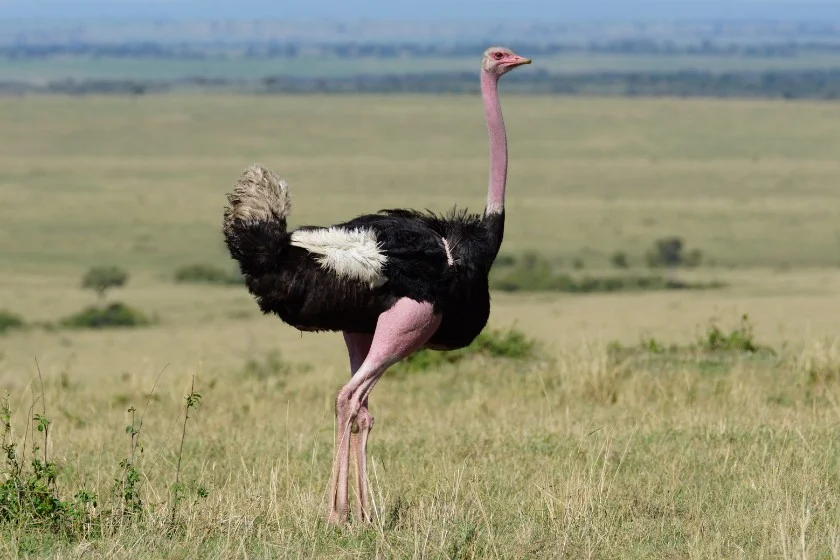
- Scientific Name: Struthio camelus
- Conservation Status: Least Concern
The common ostrich is the world’s largest and heaviest extant bird. However, such feats make the bird incapable of flight due to its immense weight.
However, the common ostrich makes up for its lack of light with speed, running up to forty-three kilometers per hour.
They are also impressive with using their long, powerful legs as defensive weapons.
A mature ostrich can grow to a height of nine feet and weigh up to 160 kilograms, a size worthy of ranking among African Safari animals one should see.
Many zoos feature ostriches in captivity, but the Kidepo Valley National Park in Uganda and the Kruger National Park in South Africa are nice places to find the common ostrich in their natural settings.
20. Shoebill
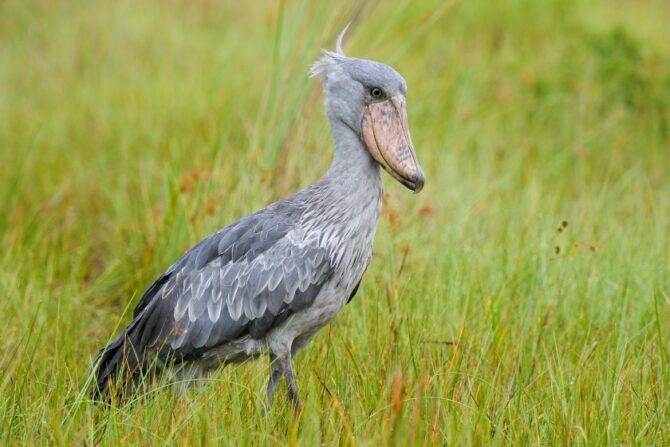
- Scientific Name: Balaeniceps rex
- Conservation Status: Near Threatened
The bird’s large, striking shoe-shaped beak earns it the distinguished name. However, its enormous bill is just one of its features.
The shoebill is one of the world’s largest birds, growing up to four feet, eleven inches, thus becoming one of the five most captivating birds in Africa, according to birdwatchers.
The shoebill can be found in the Murchison Falls National Park in Uganda, Kasanka National Park in Zambia, and a few wildlife centers in the continent present views of shoebill storks.
21. Leopard Tortoise
- Scientific Name: Stigmochelys pardalis
- Conservation Status: Least Concern
The leopard tortoise is one of the smallest wildlife Africa’s safari offers. However, the leopard markings on its shell account for the most prominent feature.
The leopard tortoise has populations scattered across Africa’s semi-arid shrubland of the Sahara, from Sudan to the cape of South Africa.
The tortoise’s leopard markings are not its only distinctive feature, but its ability to swim is unique as it is the only Testudinidae with such an ability.
The Serengeti National Park in Tanzania and Mountain Zebra National Park in South Africa are wonderful destinations to find the leopard tortoise.
22. Meerkat

- Scientific Name: Suricata suricatta
- Conservation Status: Least Concern
Mongooses are popular for killing snakes, and here is the meerkat, an animal belonging to the same family — Herpestidae.
The meerkat is a small mongoose native to Southern Africa, inhabiting arid, open habitats containing little woody vegetation in Namibia, Botswana, and South Africa.
Mongooses have a distinctive banded pattern, big eye circles, thin tails, and sharp, curved foreclaws that support digging.
They dig burrows in the Kgalagadi Transfrontier Park and Tswalu Kalahari Reserve in South Africa.
23. Kudu
- Scientific Name: Tragelaphus
- Conservation Status: Least Concern
The kudus are two large-sized antelope species found in East and Southern Africa.
The most distinctive feature differentiating both species is size, with the greater kudu measuring over five feet and the lesser kudu within the four-foot range.
They inhabit savanna near Acacia and Commiphora shrubs, relying on thickets for protection.
Therefore, these antelopes are found in the Addo Elephant National Park and Hluhluwe-Imfolozi Game Reserve in South Africa, Chobe National Park in Botswana, and Etosha National Park in Namibia.
24. Jackal
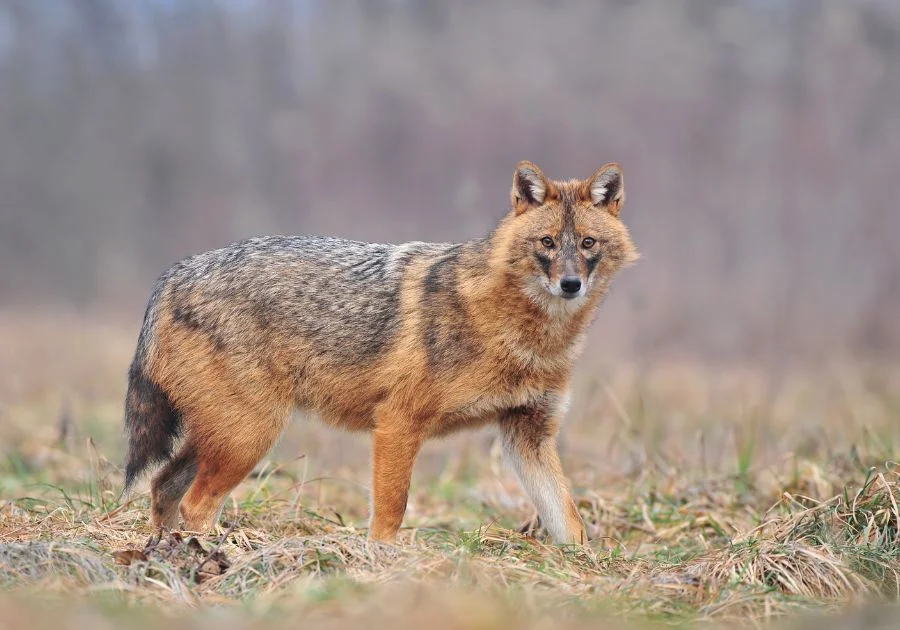
- Scientific Name: Canis aureus
- Conservation Status: Least Concern
Jackals are dog relatives of the genus Canis. Three jackal species exist — black-backed, golden, and side-striped, all occurring in different parts of Africa, especially the eastern and southern countries.
The black-backed jackal inhabits savannas and wooded areas; the golden jackal occupies dry environments, including deserts, open savannas, and arid grasslands.
The side-striped jackal lives in damp savannas, marshes, bushlands, and mountains.
Visiting the Kruger National Park, Shongweni Resources Reserve, and the wildlife parks offers the intriguing sights of jackals in South Africa.
The Tsavo West National Park in Kenya, Chobe National Park in Botswana, and Etosha National Park in Namibia are other nice places to find a jackal.
25. Cheetah

- Scientific Name: Acinonyx jubatus
- Conservation Status: Vulnerable
Watching the world’s fastest land animal stalk its prey and initiate its signature high-speed chase is a dream sight to anyone willing to enjoy the untamed beauty of the African safari.
Therefore, some of the best places to watch a cheetah in your next safari escapade include:
- Okavango Delta in Botswana
- Maasai Mara National Reserve in Kenya
- Etosha National Park in Namibia
- Phinda Private Game Reserve in South Africa
- Phinda Private Game Reserve in Tanzania
- Kidepo Valley National Park in Uganda
- Kafue National Park in Zambia
26. Impala
- Scientific Name: Aepyceros melampus
- Conservation Status: Least Concern
The Impala is one of the most elegant antelope species, featuring a graceful stride, plush, glossy, reddish brown coat, and slender, curved horns.
While you might love to admire them, it will be more thrilling to watch them jump clear of obstacles, leaping up to ten meters long and three meters high.
Such a sight lies in the Lake Mburo National Park and Katonga Wildlife Reserve in Uganda, Kruger National Park, Hluleka Nature Reserve in South Africa, and Masai Mara National Reserve in Kenya.
27. Waterbuck
- Scientific Name: Kobus ellipsiprymnus
- Conservation Status: Least Concern
It would help if You never get tired of seeing antelopes if you visit Africa for its safari.
The waterbuck is among the many antelope species you may find, especially if you cruise through Chobe National Park in Botswana, Serengeti National Park in Tanzania, Kruger National Park in South Africa, or Lake Nakuru National Park in Kenya.
Waterbucks are large, robust antelopes with reddish-brown to shaggy gray coats that become darker with age.
As the name suggests, the waterbuck depends on water, thus inhabiting areas close to water sources.
28. Kori Bustard
- Scientific Name: Ardeotis kori
- Conservation status: Near Threatened
Kori bustards are very large birds — the heaviest flying bird native to Africa. Male kori bustards weigh between seven and eighteen kilograms.
The male kori bustard’s wingspan ranges from seven feet seven inches to nine feet.
Even though they have large wings, they do not frequently fly unless necessary.
Therefore, there is much to admire in this feathered giant, bringing you to the Etosha National Park in Namibia and the Serengeti National Park in Tanzania, where it occupies sparsely wooded savannas and open grasslands.
29. Nile crocodile
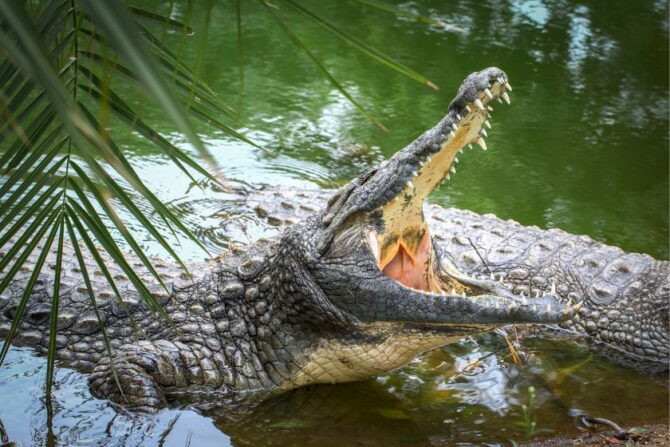
- Scientific Name: Crocodylus niloticus
- Conservation status: Least Concern
Some insects and amphibians might be insignificant during a safari escapade, but not large reptiles and apex predators like the Nile crocodile.
The crocodile occupies various habitats, including rivers, lakes, and marshes, and earns a fearsome reputation for its size, fearlessness, and extremely powerful bite.
One can find the Nile crocodile in Serengeti National Park in Tanzania, Maasai Mara National Reserve in Kenya, the Okavango Delta in Botswana, and Murchison Falls National Park in Uganda, among others.
30. Grey-crowned Crane

- Scientific Name: Balearica regulorum
- Conservation status: Endangered
The large, attractive bird, growing over three feet in height, with plush blueish-gray plumes and a golden crest, would be one of the most majestic creatures to see on one’s African safari.
The grey-crowned crane primarily inhabits dry savannas in Sub-Saharan Africa but could occur in cultivated areas and grassy flatlands in Kenya, Uganda, and South Africa.
The Amboseli and Lake Nakuru National Parks in Kenya and the Serengeti in Tanzania.
Also See: Beautiful Birds With Mohawks (With Pictures)
Frequently Asked Questions
What animals feature on Africa’s top safari?
Africa’s safari features several animals, but lions, rhinos, leopards, elephants, and buffalos are the continent’s top-five safari animals.
Some of the world’s most popular animals, including zebras, cheetahs, giraffes, and antelopes, also feature on an African safari.
Would you see a tiger on an African safari?
While Africa is home to some of the world’s largest wild cats, including lions and cheetahs, it is very unlikely to find a tiger that is not in captivity in Africa.
However, one can find the tiger in a zoo or special reserve; the Laohu Valley Reserve, Tiger Canyon, Jugomaro Predator Park, and Pilanesberg National Park in South Africa are some places to find the world’s largest wild cat.
What is the most common animal on the safari?
The lion tops most people’s wishlists of animals to find on a safari. Without a doubt, it is one animal almost everyone coming on a safari would want to see, thanks to the beast’s title as the king of the jungle and the continent’s top carnivore.
What is the largest safari animal?
Lions, giraffes, hippos, and buffalos are in contention for Africa’s largest safari animals, but they do little to match the African bush elephant (Loxodonta africana).
The mammal can grow up to 13 feet and weigh almost 23,000 pounds, more than any other safari animal.
What African habitats support wildlife?
Most African habitats support wildlife, including savannas, rainforests, semi-deserts, wooded grasslands, deserts, and plains, because they have the perfect climate and terrains to support specific animals.
Wrap Up
One might never get enough of Africa’s scenic terrains and the breathtaking explorations of its safari.
However, various challenges, including habitat degradation, human activities, and climate change, pose considerable threats to the survival of several African safari animals, driving some of these species to extinction.
Therefore, it will be more helpful for all to support conservation efforts to ensure the continuity of the continent’s beauty of undomesticated animals.
References & Notes
- Bauer H., Chapron G., et al. 2015. Lion (Panthera leo) populations are declining rapidly across Africa, except in intensively managed areas. PNAS.
- Alexis Valdes. 2018. Painted Ferocity: The Social Behaviors of African Wild Dogs, Threats to Survival, and Resulting Conservation Initiatives [pdf]. Liberty University.
- Binder W., Valkenburgh V. B. 2000. Development of bite strength and feeding behavior in juvenile spotted hyenas (Crocuta crocuta). Journal of Zoology.
- White-backed Vulture Gyps africanus. BirdLife International.



